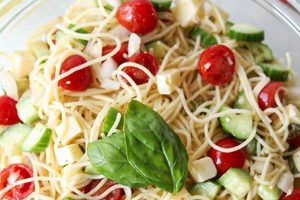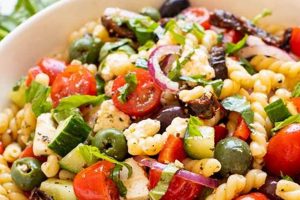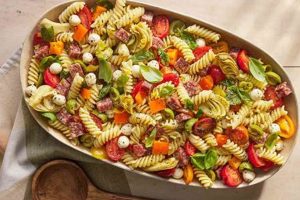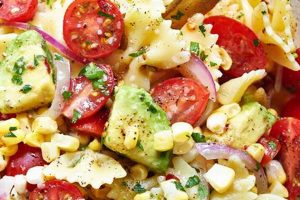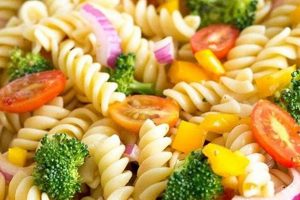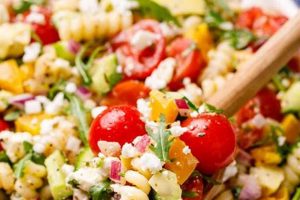This dish typically combines cooked pasta (rotini, farfalle, or other short shapes) with a medley of Mediterranean-inspired ingredients. These often include chopped vegetables like cucumbers, tomatoes, bell peppers, and red onion; Kalamata olives and feta cheese; and a vibrant dressing made with olive oil, lemon juice, garlic, and herbs like oregano and mint. Variations may incorporate other ingredients such as artichoke hearts, chickpeas, or sun-dried tomatoes.
A ready-made pasta salad offers convenience for consumers seeking a quick and flavorful meal or side dish, particularly during warmer months. The Mediterranean diet, known for its health benefits, emphasizes fresh produce, healthy fats, and whole grains, making this type of pasta salad a potentially nutritious option. Mass-produced versions offer consistent quality and large quantities suitable for gatherings and events. Such offerings represent a modern adaptation of traditional Mediterranean cuisine, reflecting consumer demand for accessible and convenient ethnic food options.
Further exploration will cover typical ingredients, nutritional information, preparation methods (for homemade versions), variations, serving suggestions, and comparisons with similar dishes.
Tips for a Successful Mediterranean Pasta Salad
Optimizing flavor and freshness involves careful ingredient selection and preparation techniques. The following tips offer guidance for creating a satisfying and authentic Mediterranean pasta salad experience.
Tip 1: Pasta Selection: Opt for short, sturdy pasta shapes that hold their shape well and capture the dressing effectively. Rotini, farfalle, penne, or fusilli are excellent choices.
Tip 2: Vegetable Freshness: Utilize ripe, in-season vegetables for optimal flavor and texture. Thoroughly wash and dry all produce before chopping.
Tip 3: Dressing Emulsification: Whisk the dressing ingredients vigorously to create a stable emulsion that coats the pasta and vegetables evenly. A small amount of Dijon mustard can aid emulsification.
Tip 4: Cheese Considerations: Authentic Mediterranean flavors benefit from the use of feta cheese. Crumble it rather than slicing for better distribution throughout the salad.
Tip 5: Herb Integration: Fresh herbs elevate the flavor profile. Finely chop herbs like oregano, mint, and parsley to maximize their impact. Add them just before serving to retain their vibrancy.
Tip 6: Chilling Time: Allow the salad to chill for at least 30 minutes before serving to allow the flavors to meld and the pasta to absorb the dressing. Avoid excessive chilling, which can dull the flavors.
Tip 7: Portion Control and Storage: Serve the pasta salad in appropriate portions. Store leftovers promptly in an airtight container in the refrigerator for up to three days.
By following these guidelines, one can achieve a well-balanced and flavorful Mediterranean pasta salad, maximizing the taste and quality of the ingredients.
These tips provide a strong foundation for exploring recipe variations and adapting them to individual preferences.
1. Ingredients
Ingredient composition directly influences the flavor profile, nutritional content, and overall quality of a pre-made Mediterranean pasta salad. Careful selection and balancing of components are crucial for achieving the desired taste and texture. Common ingredients include pasta (typically rotini or other short shapes), vegetables (such as cucumbers, tomatoes, bell peppers, and red onion), cheese (feta being the most traditional), and a vinaigrette-style dressing. Variations may incorporate olives (Kalamata or black), artichoke hearts, or chickpeas. The quality and freshness of these ingredients significantly impact the final product’s palatability. For example, using ripe, in-season tomatoes contributes a brighter, sweeter flavor compared to using out-of-season tomatoes. Similarly, high-quality olive oil enhances the dressing’s richness and complexity. The proportion of each ingredient also plays a critical role; an overabundance of pasta can result in a bland salad, while too much feta can make it overly salty.
Examining the ingredient list allows consumers to assess the product’s nutritional value and identify potential allergens. Ingredients are typically listed in descending order by weight, providing insight into the primary components. Consumers seeking a lighter option might choose a salad with a higher proportion of vegetables. Awareness of ingredient specifics allows individuals with dietary restrictions, such as gluten intolerance or dairy allergies, to make informed choices. The ingredient list also provides a basis for comparing similar products from different brands, enabling consumers to select options aligned with their preferences and dietary needs. For instance, a consumer seeking a more authentic Mediterranean flavor profile might look for a salad containing Kalamata olives and feta cheese, while someone avoiding high-sodium foods would scrutinize the sodium content related to specific ingredients.
Understanding the role and interplay of ingredients in a pre-made Mediterranean pasta salad enables informed purchasing decisions. This knowledge empowers consumers to select products that meet their expectations for taste, nutrition, and quality. Analyzing ingredient lists provides insights into flavor profiles, potential allergens, and overall nutritional value. This awareness facilitates a more discerning approach to food choices, supporting individual dietary needs and preferences. It also allows for comparisons between different brands and products, contributing to a more informed and satisfying consumer experience.
2. Nutritional Value
Nutritional value represents a key consideration when evaluating prepared food items like Mediterranean pasta salad. Understanding the nutritional composition allows consumers to make informed choices aligned with dietary goals and health considerations. This analysis explores key nutritional facets of such a product.
- Calorie Content
Calorie content provides a measure of energy provided by a serving. This factor is crucial for individuals managing weight or adhering to specific caloric intake targets. Calorie density is influenced by the proportion of ingredients like pasta, cheese, and dressing. A higher pasta-to-vegetable ratio generally corresponds to a higher calorie count.
- Macronutrient Breakdown
Macronutrientscarbohydrates, proteins, and fatsplay distinct roles in the body. Mediterranean pasta salad typically contains a significant carbohydrate contribution from pasta, protein from cheese and potentially chickpeas or other legumes, and fats from the dressing and cheese. The specific ratio of these macronutrients influences satiety and energy levels. The type of fat present is also relevant; olive oil in the dressing contributes monounsaturated fats, generally considered beneficial for heart health.
- Micronutrient Profile
Micronutrients, including vitamins and minerals, are essential for various bodily functions. Vegetables in the salad contribute vitamins such as Vitamin C and Vitamin A. Feta cheese provides calcium. Analyzing the micronutrient content allows consumers to assess the nutritional density and potential health benefits. For instance, a salad rich in colorful vegetables offers a wider range of vitamins and antioxidants.
- Sodium Content
Sodium content is a significant consideration for individuals monitoring sodium intake due to health concerns like hypertension. Processed foods, including pre-made salads, can sometimes be high in sodium. Feta cheese and certain dressings contribute significantly to sodium levels. Examining the sodium content per serving allows consumers to make informed choices aligned with dietary guidelines.
Careful consideration of these nutritional facets contributes to a comprehensive understanding of a pre-made Mediterranean pasta salad’s overall dietary impact. Analyzing calorie content, macronutrient ratios, micronutrient density, and sodium levels empowers consumers to make informed food choices that support individual health goals and dietary requirements. This awareness facilitates a more mindful and health-conscious approach to food selection and consumption. Comparing nutritional information across different brands or variations allows for optimized decision-making aligned with individual needs.
3. Serving Size
Serving size plays a critical role in understanding the nutritional implications and overall consumption experience of a pre-made Mediterranean pasta salad from a bulk retailer. The designated serving size provides a standardized unit for assessing calorie intake, macronutrient distribution, and micronutrient consumption. Deviation from the recommended serving size directly impacts the actual amount of nutrients consumed. For instance, consuming double the suggested serving size doubles the calorie, fat, and sodium intake. This understanding is crucial for individuals managing specific dietary requirements or health conditions.
Bulk-purchased pasta salad presents a unique challenge regarding serving size adherence. The large volume encourages consumption beyond individual portions. Practical strategies for managing serving sizes include pre-portioning the salad into individual containers upon purchase. This approach facilitates portion control and promotes mindful consumption. Using smaller plates and bowls can also create a visual cue for appropriate portioning. Understanding the relationship between serving size and nutritional information empowers consumers to accurately assess their intake and make informed choices aligned with dietary goals. For example, if the nutritional label indicates a serving size of one cup containing 300 calories, consuming two cups equates to 600 calories. This awareness facilitates accurate calorie tracking and supports informed dietary decision-making.
Effective portion management contributes to a balanced and mindful approach to consuming bulk-purchased foods. Understanding the connection between serving size, nutritional content, and overall consumption volume allows individuals to align their dietary habits with health goals. Practical strategies like pre-portioning and using smaller serving dishes facilitate adherence to recommended serving sizes. This awareness empowers consumers to maximize the benefits of convenient food options while maintaining dietary awareness and control.
4. Preparation Method
Preparation method, while minimal for a pre-made product like Sam’s Club Mediterranean pasta salad, still influences the final consumption experience. Understanding these steps, though simple, ensures optimal enjoyment and food safety. This examination clarifies the relevant preparation aspects.
- Serving
Serving a pre-made pasta salad primarily involves transferring the desired portion from the bulk container to individual plates or bowls. Utensils appropriate for serving pasta, such as large spoons or tongs, facilitate this process. Attention to hygiene is essential; using clean serving utensils prevents cross-contamination and maintains food safety.
- Temperature
Pre-made pasta salad is typically served chilled. Maintaining the appropriate temperature preserves food quality and enhances the flavor profile. Serving the salad directly from refrigeration ensures optimal temperature. Avoid leaving the salad at room temperature for extended periods, as this can compromise food safety and lead to bacterial growth.
- Portioning
Portioning is crucial for managing calorie intake and aligning consumption with dietary goals. Using appropriate serving sizes, as indicated on the product label, facilitates accurate portion control. Pre-portioning the salad into individual containers after purchase can assist with portion management and prevent overconsumption.
- Additions and Modifications
While the pre-made salad is designed as a complete dish, some individuals may choose to add or modify ingredients. Adding grilled chicken or fish can increase protein content. Incorporating additional vegetables enhances nutritional value. However, such modifications should be considered when assessing the overall nutritional profile of the meal. For instance, adding high-calorie ingredients can significantly increase the total calorie count.
Even with minimal preparation steps, understanding serving temperature, portion control, and potential modifications allows for a more informed and satisfying consumption experience. Adhering to safe food handling practices, like using clean serving utensils and maintaining appropriate temperature, ensures food safety and maximizes product quality. These considerations, though seemingly simple, contribute significantly to the overall enjoyment and nutritional management of Sam’s Club Mediterranean pasta salad.
5. Storage Instructions
Proper storage is crucial for maintaining the quality and safety of Sam’s Club Mediterranean pasta salad. Given its perishable natureincorporating fresh vegetables, cheese, and a vinaigrette-based dressingincorrect storage can lead to spoilage, bacterial growth, and foodborne illness. Adherence to recommended storage practices preserves the product’s flavor, texture, and nutritional value while mitigating health risks. This connection between storage instructions and the product’s composition underscores the importance of proper handling.
Typically, storage instructions recommend refrigeration at temperatures below 40F (4C). This temperature range inhibits bacterial proliferation, extending the product’s shelf life. Airtight containers are essential for preventing the salad from drying out and absorbing odors from other refrigerated items. Exposure to air accelerates oxidation, affecting the flavor and texture of ingredients like vegetables and dressing. Furthermore, storing the salad in a shallow container, rather than a deep one, promotes even cooling and reduces the risk of bacterial growth in warmer areas of the container. For instance, a large, tightly sealed container minimizes air exposure and maintains consistent temperature, preserving the salad’s freshness for a longer period.
Failure to adhere to proper storage instructions can have significant consequences. Leaving the salad at room temperature for extended periods, especially in warm environments, creates a breeding ground for bacteria. This can lead to foodborne illnesses if consumed. Improperly sealed containers result in dried-out ingredients, compromised flavor, and altered texture. Understanding and following storage instructions is therefore essential not only for maintaining the quality of the product but also for safeguarding consumer health. This knowledge empowers consumers to maximize the shelf life and enjoyment of the product while minimizing potential health risks associated with improper storage.
6. Flavor Profile
Flavor profile constitutes a defining characteristic of any culinary creation, especially prepared food items like Sam’s Club Mediterranean pasta salad. Understanding the interplay of flavors provides insight into the product’s appeal and potential suitability for individual palates. Analysis of key flavor components contributes to a comprehensive appreciation of this particular dish.
- Savory Foundation
The savory foundation typically derives from the combination of pasta, olives, and feta cheese. Pasta, though relatively neutral in flavor, absorbs the flavors of the other ingredients. Olives, particularly Kalamata olives, contribute a briny, salty taste. Feta cheese adds a tangy, salty element that complements the other savory components. This base establishes the overall savory character of the salad.
- Acidic Brightness
Acidity, primarily from the vinaigrette dressing, balances the savory elements and provides brightness. Lemon juice or red wine vinegar are common acidic components. This tartness cuts through the richness of the cheese and olives, preventing the flavor profile from becoming overly heavy. The balance of acidity is crucial for a refreshing and palatable salad.
- Herbal Complexity
Fresh herbs often contribute an additional layer of complexity. Oregano, mint, and parsley are common additions to Mediterranean-inspired dishes. These herbs introduce aromatic notes that complement the other flavors. Oregano provides a slightly peppery, earthy flavor, while mint adds a refreshing coolness. The careful balance of herbs enhances the overall flavor complexity.
- Vegetable Freshness
Fresh vegetables contribute not only texture but also subtle flavors that complement the overall profile. Cucumbers provide a refreshing, slightly sweet taste. Tomatoes offer a juicy sweetness and slight acidity. Bell peppers contribute a mild sweetness with a hint of vegetal flavor. Red onion introduces a pungent, slightly sweet note. The combination of these fresh vegetables adds depth and complexity to the salad.
The interplay of these flavor components defines the characteristic flavor profile of Sam’s Club Mediterranean pasta salad. The balance of savory, acidic, herbal, and fresh vegetable notes creates a complex yet harmonious taste experience. Understanding these elements allows consumers to anticipate the flavor profile and assess its alignment with individual preferences. This knowledge contributes to informed purchasing decisions and a more satisfying culinary experience.
7. Consumer Appeal
Consumer appeal for a product like a pre-made Mediterranean pasta salad hinges on several interconnected factors. Convenience plays a significant role; consumers seek ready-to-eat options that require minimal preparation, particularly for busy lifestyles or large gatherings. Perceived health benefits also contribute to the product’s attractiveness; the Mediterranean diet’s association with health and wellness resonates with health-conscious consumers. The salad’s colorful appearance and fresh ingredients further enhance its appeal, suggesting a vibrant and nutritious meal option. Favorable pricing compared to restaurant or individually prepared versions increases accessibility and reinforces value perception. For example, families seeking a quick and healthy picnic option might choose this salad due to its ease of transport and perceived nutritional value. Similarly, event organizers might opt for bulk-purchased pasta salad as a cost-effective catering solution for large groups. The convergence of convenience, perceived health benefits, visual appeal, and affordability drives consumer interest and purchasing decisions.
Product placement and marketing strategies further influence consumer behavior. Placement within high-traffic areas of warehouse clubs maximizes product visibility and encourages impulse purchases. Promotional signage emphasizing freshness, health benefits, or value can sway purchasing decisions. Seasonal promotions aligned with peak demand periods, such as summer months or holidays, capitalize on consumer trends and drive sales. For instance, displaying the salad near grilled meats or other picnic staples creates a convenient meal solution and encourages bundled purchases. Effective marketing campaigns resonate with consumer desires for healthy, convenient, and affordable meal options, amplifying the product’s inherent appeal and translating interest into sales.
Understanding the factors driving consumer appeal allows for effective product development and marketing. Addressing consumer needs for convenience, health, and value while leveraging strategic placement and promotional activities maximizes market penetration and brand loyalty. Analyzing purchasing patterns and consumer feedback provides valuable insights for product refinement and targeted marketing campaigns. This iterative process of understanding and responding to consumer preferences ensures continued product relevance and sustained market success. Balancing these elements contributes to a product that resonates with consumer needs and preferences, fostering long-term market viability.
Frequently Asked Questions
This section addresses common inquiries regarding pre-made Mediterranean pasta salad, providing concise and informative responses.
Question 1: What is the typical shelf life of refrigerated, pre-made Mediterranean pasta salad?
Shelf life varies depending on factors like ingredient freshness and storage conditions, but typically ranges from 3 to 5 days when refrigerated properly according to package instructions.
Question 2: Can one freeze pre-made Mediterranean pasta salad?
Freezing is generally not recommended. Freezing alters the texture of vegetables and pasta, negatively impacting overall quality upon thawing.
Question 3: Is this type of pasta salad generally considered a healthy meal option?
While it incorporates elements of the Mediterranean diet (vegetables, olive oil), nutritional content varies. Consumers should examine nutritional labels carefully, considering factors like calorie density, sodium content, and saturated fat levels.
Question 4: How can one adapt pre-made Mediterranean pasta salad to accommodate dietary restrictions, such as gluten intolerance or veganism?
Gluten-free versions may exist; consumers should check product labels. Adapting for veganism requires omitting feta cheese and ensuring the dressing contains no animal products.
Question 5: Are there common allergens present in this type of pasta salad?
Common allergens include gluten (from pasta), dairy (from feta cheese), and soy (potentially in the dressing). Consumers with allergies should carefully examine ingredient lists.
Question 6: What are suitable accompaniments to serve alongside Mediterranean pasta salad?
Complementary pairings include grilled chicken or fish, crusty bread, or a simple green salad. Consider flavor profiles and nutritional balance when selecting accompaniments.
Careful consideration of these frequently asked questions equips consumers with the information necessary for informed purchasing and consumption decisions. Understanding product characteristics, storage guidelines, and potential allergens supports a safe and satisfying culinary experience.
The following section offers additional resources for further exploration of Mediterranean cuisine and healthy eating habits.
Conclusion
Analysis of a mass-market Mediterranean pasta salad formulation reveals key considerations spanning ingredients, nutritional value, preparation, storage, flavor profile, and consumer appeal. Ingredient quality and proportion directly impact nutritional value and flavor complexity. Understanding serving size and storage guidelines ensures safe consumption and maximizes product longevity. The interplay of savory, acidic, herbal, and fresh elements defines the characteristic flavor profile, while convenience, perceived health benefits, and visual appeal contribute to consumer demand. Effective marketing strategies leverage these factors to influence purchasing decisions.
Continued exploration of consumer preferences and evolving dietary trends remains essential for product refinement and market adaptation within the prepared foods sector. Careful consideration of ingredient sourcing, nutritional balance, and flavor optimization offers opportunities to enhance product quality and meet consumer expectations for convenient, healthy, and flavorful meal solutions.

